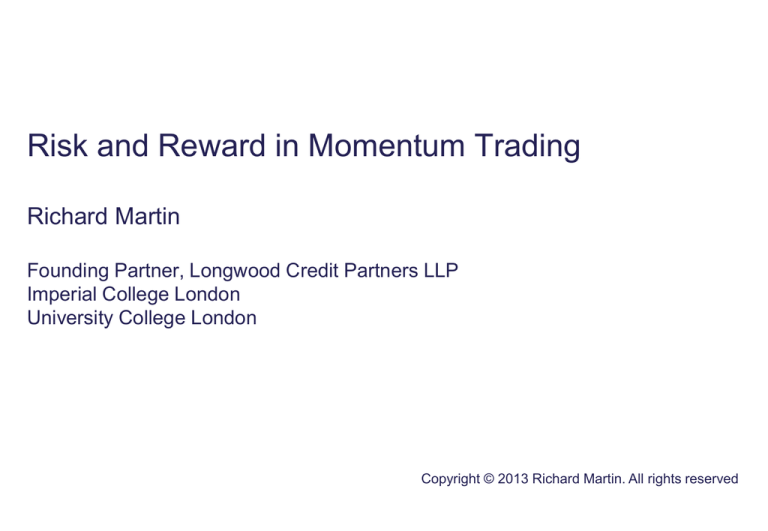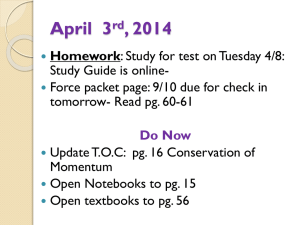
Risk and Reward in Momentum Trading
Richard Martin
Founding Partner, Longwood Credit Partners LLP
Imperial College London
University College London
Copyright © 2013 Richard Martin. All rights reserved
What momentum trading is
•
Flippantly: Buy high and sell low
•
What I actually mean by this is: Buy high, sell higher; Sell low, buy (back) lower
•
Or: Buy what is going up, sell what is going down
•
“It works because ...”
– anchoring bias
– information leakage
– in some asset classes (short-term govt bonds, STIRs) Government policy
2
Is it really that simple?
•
Buy what is going up; sell what is going down
•
“Momentum investing shouldn’t work. Markets are supposed to be efficient ... But it does
work, prompting Eugene Fama to describe it as ‘the premier anomaly’. The team at
London Business School mined their database of long-term stock returns all the way back
to 1900 and found that buying the 20 best performers from the 100 biggest UK shares
generated an average annual return of 14.1%” (Jonathan Eley, FT, 8 Mar 2013)
•
“If momentum investing is so simple, why don’t more people do it? One reason might be
that its crudeness offends our intellectual sensibilities. Investing is supposed to involve a
degree of judgment and intelligence, whereas momentum is a mechanical process
involving little conscious thought. Anyone could do it.” (ibid)
3
Specific conclusions of this talk
•
The first moment (expected return) is a matter of empiricism/belief
•
But the second and third moments of momentum trading returns are of technical interest
•
Momentum trading returns are known to have positive skewness
– thus they hold onto profits, which is good
– also implies that the proportion of winning trades may be less than one-half
– this is true even if expected return is zero
– intriguing and useful that we can design skewness into a trading strategy
•
How does this help us design systems?
4
Design principles
•
General trading principle (not just momentum): Scale positions inversely to volatility
– thereby keeping bets evenly-sized
– or, strategy (trading) returns have roughly constant volatility as a result
•
so, position “signal” vol : t t G / t2 t G / t
•
“Signal” will be related to previous price history: >0 in uptrend, <0 in downtrend
– essentially, all these operate by taking weighted average of previous returns
– we will do this using exponentially-weighted moving averages, though we don’t have to
•
Transaction costs
– as each time we change position we incur costs
– not for this seminar, but I have done quite a bit of work in this area
5
Moving averages
•
A common device in momentum / technical analysis is the moving average
•
Use exponentially-weighted (EMA) and compare either of:
– EMA1: spot minus moving average. When spot > EMA, uptrend
– or EMA2: fast minus slow
– example: USDJPY
6
Filter weights for EMA1 and EMA2
0.35
EMA1 (16)
0.30
EMA2 (8:16)
0.20
0.15
filter weight
0.25
0.10
0.05
0.00
70
60
50
40
30
20
10
0
lag
7
SP1 momentum signals
3
2
Momentum signals are
smoothed return series
(above).
They also follow the
price series (below).
1
0
02-Jan-12
-1
-2
-3
02-Jul-12
01-Jan-13
Returns (risk-adj.)
Signal (16:32)
Signal (8:16)
3
1600
2
1500
(NB : SPX Index is the
index level and is shown
as a convenient guide.
The implementation uses
SP1, the front futures.)
1
0
02-Jan-12
-1
-2
-3
1400
02-Jul-12
01-Jan-13
Signal (16:32)
Signal (8:16)
SPX Index
1300
1200
8
Some technicalities
•
Two simple things were done that I’ve not mentioned, both pertinent to standardisation.
1. Adjusted the returns for volatility
– obtained by averaging squared returns and imposing a floor (a pretty standard idea)
2. Divided by a normalising constant so that the momentum signal has unit std deviation
EMA 2
j 1
( X n j X n j 1 )
j 0
j 1
( X n j X n j 1 )
j 0
1
( )
(1 )( 1 2 )( 1 2 )
•
1/ 2
Now, any asset class will give momentum signals that “look the same”
– a bit like a “common currency” for momentum
9
Turning a momentum signal into a position
•
Binary rule (already covered): = sgn(mom)
– Pro: simple, positions bounded
– Con: sudden change in position at the origin.
– Con: no positive skew in trading returns (►►)
•
Linear rule: = mom
– Pro: simple
– Con: unbounded position
•
transformed
= (z)
“Optimal” shape shown : = (mom)
– Bounded position
– Smooth behaviour
– Takes risk off when trend v strong
•
raw signal
Linear combination of different speeds
10
And here is a typical result
•
USDJPY using 8:16
•
Notice characteristic pattern of the trading returns. Up fast, down slow.
140
120
Account
100
80
60
40
20
0
02-Apr-86
-20
02-Apr-90
02-Apr-94
02-Apr-98
02-Apr-02
02-Apr-06
02-Apr-10
11
Skewness seen empirically
•
USDJPY using 8:16
•
SR ~ +0.50 but success rate 48% (?!)
0.16
0.14
JY1, 8:16, 50D ret
0.12
0.10
0.08
0.06
0.04
0.02
0.00
-2
-1.5
-1
-0.5
0
0.5
1
1.5
2
2.5
3
3.5
4
return (per unit stdev)
12
Statistical characteristics of momentum systems
•
Skewness of trading returns is positive, under general assumptions
– This is quite robust to market environment
– Correct even during ‘fallow periods’ where money is not being made
– R J Martin and A Bana, “Nonlinear momentum strategies”, RISK, Nov 2012
– R J Martin and D Zou, “Momentum trading: ‘skews me”, RISK, Aug 2012
– M Potters and J-P Bouchaud, “Trend follows lose more often than they gain”, Wilmott, Nov 2005
– E Acar and S Satchell, “Advanced trading rules”, Butterworth-Heinemann, 2002
•
Derivation of second and third moments of trading returns
•
Calculation in special cases
•
Linear and nonlinear systems, i.e. incorporate the response function we saw earlier
•
Hybrid systems which combine positive and negative momentum bets
13
Trading returns: moments
•
Period-M trading return, with X the adjusted price of the instrument:
•
First moment is zero (assuming independent returns)
•
Second and third moments
•
which evaluate to
•
returns are uncorrelated but not independent
14
Linear systems
•
Signal is a weighted (linear) combination of previous returns
•
Expression for third moment in terms of autocorrelation function
•
where autocorrelation function R is, in terms of the filter weights:
15
Trading returns: basic characteristics of skewness
•
Second moment is directly proportional to M
•
Third moment is proportional to M2 for small M, but to M for large M
•
So skewness is proportional to M+1/2 for small M, but to M1/2 for large M
•
Sketch for a pure-momentum system (all filter weights positive):
skewness
return period, M
16
Linear systems
•
EMA1, weighting is an exponential
•
where = 11/N and N = ‘period’ or ‘lookback’, e.g. N=20 gives =0.95
•
EMA2, weighting is a difference of exponentials
•
where = 11/N and = 11/N
•
From these I can calculate R, & then second and third moments, & then the skewness
17
Skewness term structure
•
EMA1 and EMA2
•
Slower oscillators basically stretch in horizontal direction
18
Skewness term structure, empirically
•
We have done analysis on basis that mean trading return = 0
•
However, trend following does work! So mean won’t be zero
•
So plot central skew (moments about mean) & non-central skew (moments about 0)
•
CHFUSD and SPX. NB: empirical estimation of skew is very sensitive to outliers
19
Hybrid systems
•
5:10 (short-term) and 20:40 (longer-term) oscillators
•
Red: negative bet on short-term momentum, positive bet on longer-term
•
Green: positive bet on short-term momentum, “small” negative bet on longer-term
20
Nonlinear systems
•
As before, momentum factor is going to be weighted combination of risk-adjusted returns
and position θ = / (= signal vol):
•
Third moment
•
and this can be evaluated via
•
where (Z1,Z2) ~ standard Bivariate Normal with correl
21
Choice of
•
For some choices of , the expectation (double-integral) can be evaluated in closed form
•
Two such:
22
Results for double-step
Narrower separation
Lower skewness.
Zero separation
No skewness (Why?)
N=20,40 throughout
23
Results for sigmoid
Position-limiting
reduces skewness
24
Results for reverting sigmoid
Fast reversion causes
negative skewness.
Critical ~ 1.3
25
Optimisation of
•
Can now consider two criteria
1. The classical Sharpe ratio
– take a selection of futures contracts
– backtest each one individually and take average SR as the objective function
– try different shapes
2. Skewness
– no backtesting of this required! Just compute the skewness analytically
– and go for highest skewness you can
•
Of course, these two may well conflict
26
Optimising the double-step
•
Optimal ~ 0.6: SR not affected, but skewness higher
27
Optimisation of a smooth function
•
We can take a linear combination of the two sigmoids 2 ( ( z ) 1),
2
ze
2
z / 2
– if we choose the same for each, then we have two parameters, and the weight-ratio
•
Use on a universe of different futures contracts and trading speeds
•
Two criteria, as we wish to maximise Sharpe ratio and Skewness
– SR: the performance surface rather flat, i.e. hard to be confident about “best” soln.
– SR prefers reverting sigmoid ze
2
z
2
/2
– but skewness doesn’t
– so we get a compromise like this:
28
Optimisation of a smooth function
Sharpe
Linear
Linear
Skew
Reverting
Saturating
29
In the words of Alexander Pope
•
The famous triplet (not couplet, as is often supposed):
Nature and nature’s laws lay hid in night;
God said, “Let Newton be!” and all was light;
Ride good, cut bad, for this we find is right.








